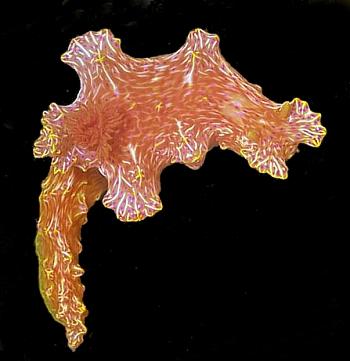
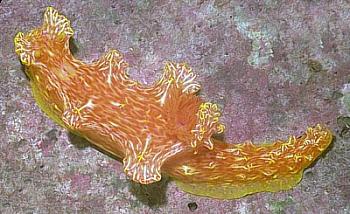
Ceratosoma moloch
Rudman, 1988
Order: NUDIBRANCHIA
Suborder: DORIDINA
Superfamily: EUDORIDOIDEA
Family: Chromodorididae
DISTRIBUTION
Western Pacific
PHOTO
NW of Point Lookout, Nth Stradbroke Is, sthn Queensland, Australia, 11m, 29 July 1985, Paratype AM C147845. 112mm long alive. PHOTOS: R.C.Willan.
Two specimens from Heron Island had a pink background colour with whitish pink tubercles and tuberculate regions outlined with an irregular band of cream. There is an irregular whitish border along the edge of the foot. The rhinophores are a translucent pink with some white specks but no white tip to the club. The gills are translucent pink.
A smaller specimen from North Stradbroke Island is translucent pink with mottled reddish pink all over. On the dorsum there are whitish longitudinal streaks which on the lateral mantle lobes become transverse and radial lines. These lines are bright white changing to yellow near the edge. Each tubercle, both on the lateral lobes and elsewhere on the body, has a series of white or yellow lines running up to the tip. Scattered over the lobes, and on the larger tubercles on the foot are diffuse purple spots. These are also found around the edge of the foot which is tinged with yellow.
The rhinophores are a yellowish orange with some white specks on the club. The gills are translucent orange with a thin reddish line along the rachis.
The mantle skirt has been reduced to three flattened tuberculate lobes on each side of the body. There are a pair on either side of the head and a large pair just in front of the gills. The third pair are midway between the head and gill lobes. In the midline, just behind the gills the posterior end of the mantle is produced into a large recurved horn. In the larger specimen the middle and posterior pair of lobes and the posterior horn have become rounded and multituberculate. Between the lobes the mantle edge is either reduced to a slight ridge or absent. There are a few small conical tubercles on the mantle and some beneath on the sides of the body. Behind the mantle however the posterior foot is heavily tuberculate with many of the more dorsal tubercles being compound.
Reference:
• Rudman, W.B. (1988) The Chromodorididae (Opisthobranchia: Mollusca) of the Indo-West Pacific: the genus Ceratosoma J.E. Gray. Zoological Journal of the Linnean Society, 93(2): 133-185.
Rudman, W.B., 2000 (December 29) Ceratosoma moloch Rudman, 1988. [In] Sea Slug Forum. Australian Museum, Sydney. Available from http://www.seaslugforum.net/find/ceramolo
Related messages
Colour variation in Ceratosoma moloch
June 2, 2008
From: David Mullins
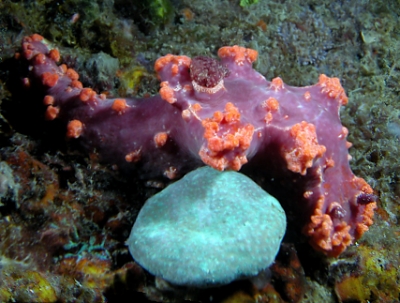
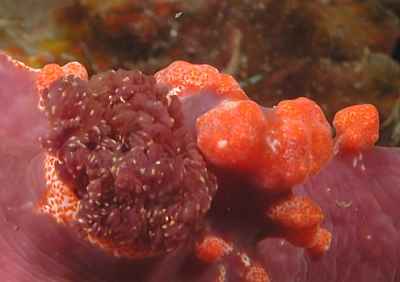
Concerning message #21290:
Dear Bill,
From a distance this specimen of Ceratosoma moloch certainly had me thinking I was looking at a type of soft coral at first.
The colour variations we are finding here of this species are without doubt remarkable. This particular example is very similar to that previously found at Heron Island on the Great Barrier Reef.
It is undoubtedly a delight to find and photograph a large species like this for a change. Included are close ups of rhinophores and gills.
Locality: Old Woman Island (Mudjimba Island) Maroochydore, Sunshine Coast,, 9 metres, Queensland, Australia., Pacific Ocean, 17 May 2008, Rocky slope. Length: 180 mm. Photographer: David Mullins.
Kind regards,
David Mullins.
marineimages@hotmail.com
Mullins, D.A., 2008 (Jun 2) Colour variation in Ceratosoma moloch. [Message in] Sea Slug Forum. Australian Museum, Sydney. Available from http://www.seaslugforum.net/find/21611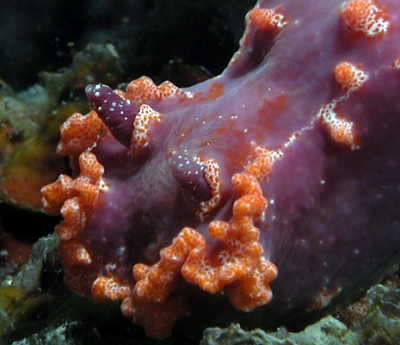
Thanks David,
It is interesting to see all the colour varaints. I must say 180 mm is certainly the largest animal I can recall hearing about
Best wishes,
Bill Rudman
Ceratosoma moloch found sthrn Queensland
December 13, 2007
From: Gary Cobb
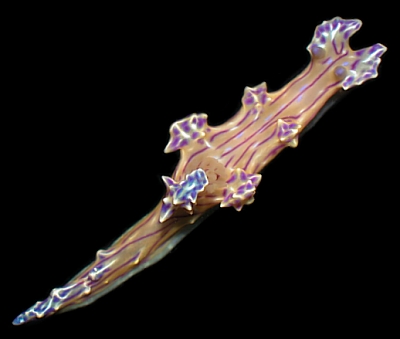
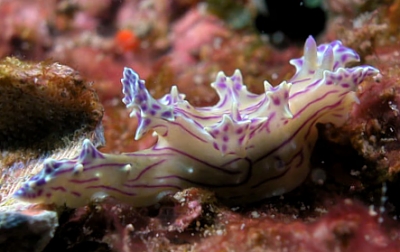
Hi Bill and everyone!
Well it might be a young animal, but Ceratosoma moloch has finally been found here on the Sunshine Coast. Depending on the light there is an orange tint to it's body.
Locality: Hanging Rock, Mooloolaba, 17 m, Queensland, Australia, Pacific Ocean, 08 December 2007, Subtidal. Length: 27 mm. Photographer: Gary Cobb.
The dive was at Hanging Rock off Mooloolaba in 17 m of water with about 25 m vis. On the dive which lasted 160 minutes we photographed 27 species of nudibranhs. It was quite nice to say the least!
Cheers
Gary Cobb
gary@nudibranch.com.au
Cobb, G.C., 2007 (Dec 13) Ceratosoma moloch found sthrn Queensland. [Message in] Sea Slug Forum. Australian Museum, Sydney. Available from http://www.seaslugforum.net/find/21290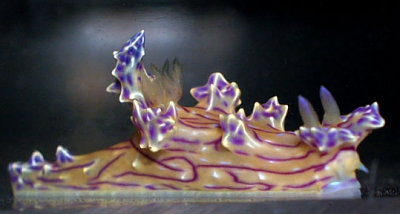
Dear Gary,
Thanks for this record. It's interesting how even at this relativley small size it has its full adult shape - but I must say I have never seen one with purple lines like this.
Best wishes,
Bill Rudman
Re: Ceratosoma moloch from southern Queensland, Australia [2]
September 1, 2006
From: Bruce Wilkie
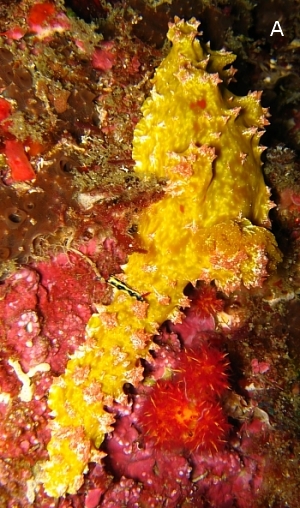
Concerning message #17694:
Hi Bill,
Here is some more feeding info for you on Ceratosoma moloch. This animal is a different colour from the animal in my original message (no purple spots). It is similar to Bob Bolland`s animal from Okinawa [#5042 ].
You will see Hypselodoris infucata crawling over it`s tail.
I have come across these animals several times now, and they always seen to be on or near by these brown sponges.
Locality: Flat Rock North Stradbroke Island, 12mts, Queensland Australia, Pacific Ocean, 8th July 2006, Rocky reef with hard & soft corals & sponges. Length: approx 125mm. Photographer: Bruce Wilkie.
Many Thanks,
Bruce Wilkie.
brucedwilkie@yahoo.com.au
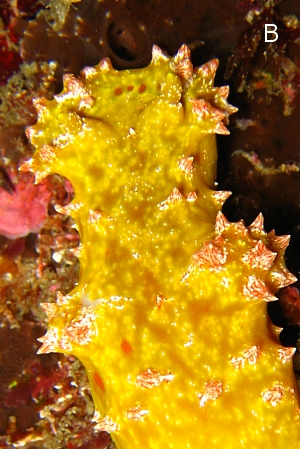
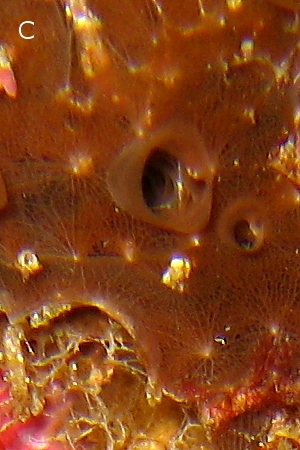
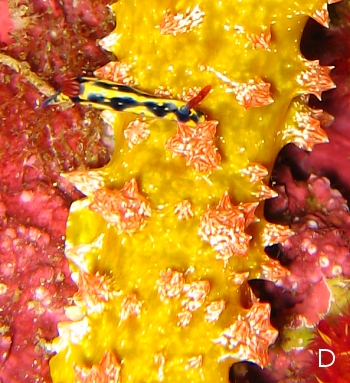
Dear Bruce,
Thanks for this second record of it feeding sponge. In photo A there are signs of the brown sponge all down the right side and in the upper half of the left side. In your high resolution files I can see that this appears to be a single colony with parts of it overgrown with other growths or covered in detritus. In photo C what appears ro be signs of damage can be seen in the bottom left corner with only the white fibrous skeleton remaining. This is definitely a dysideid.
I've added a close-up of the 'tail' [photo D ] to show the lack of purple spots in this colour form, and the small Hypselodoris infucata you mentioned.
Best wishes,
Bill Rudman
Re: Ceratosoma moloch from southern Queensland, Australia [1]
September 1, 2006
From: Bruce Wilkie
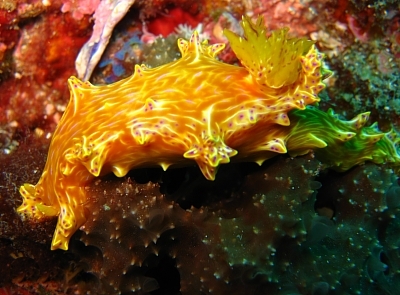
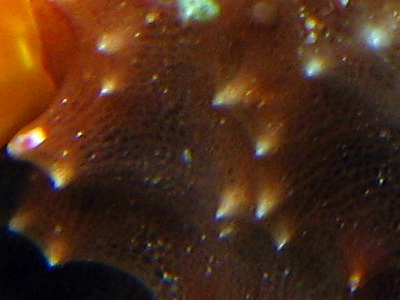
Concerning message #15863:
Hi Bill,
Here is some feeding info for you on Ceratosoma moloch. I have come across these animals several times now, and they always seen to be on or near by these brown sponges.
Locality: Flat Rock North Stradbroke Island, 12mts, Queensland Australia, Pacific Ocean, 15th April 2006, Rocky reef with hard & soft corals & sponges. Length: 125mm. Photographer: Bruce Wilkie.
I have included a record of another animal on the same sponge in a separate message [#17682 ]
Many Thanks,
Bruce Wilkie.
brucedwilkie@yahoo.com.au
Wilkie, B.D., 2006 (Sep 1) Re: Ceratosoma moloch from southern Queensland, Australia [1]. [Message in] Sea Slug Forum. Australian Museum, Sydney. Available from http://www.seaslugforum.net/find/17694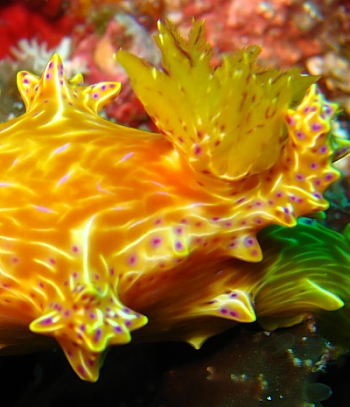
Dear Bruce,
Thanks for another excellent discovery. This is the first records we have of this species feeding. The fact that you are finding the species regularly association with this sponge is good evidence, as are these two messages which show different animals with the heads down in the sponge. I am pretty sure the sponge is a dysideid.
Best wishes,
Bill Rudman
Ceratosoma moloch from southern Queensland, Australia
February 20, 2006
From: Bruce Wilkie
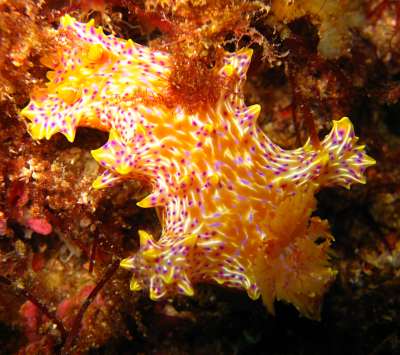
Hi Bill,
I have ID this animal as Ceratosoma moloch.
Thought you might like it for your records.
Locality: Manta Bommie, Point Lookout, North Stradbroke Island, 10 metres, Queensland, Australia, Pacific ocean, 14 January 2006, rocky reef with sponges, hard & soft corals . Length: 120 mm. Photographer: Bruce Wilkie.
Many thanks,
Bruce Wilkie.
brucedwilkie@yahoo.com.au
Wilkie, B., 2006 (Feb 20) Ceratosoma moloch from southern Queensland, Australia. [Message in] Sea Slug Forum. Australian Museum, Sydney. Available from http://www.seaslugforum.net/find/15863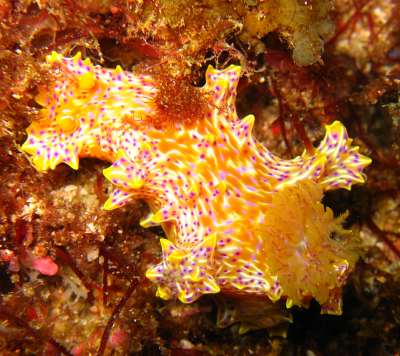
Dear Bruce,
Yes its nice to get any records of rarely seen species as it's the only way we will ever build up information on their colour, shape, distribution and general biology. It looks like this animal is feeding but unfortunately whatecer sponge it is interested in is well hidden.
The reason I called this species moloch was because the first time I saw it, ir reminded me of that icon of the Australian desert, an endemic lizard called the Thorny Devil - Moloch horridus.
Best wishes,
Bill Rudman
Ceratosoma moloch from Okinawa
August 23, 2001
From: Bob Bolland

Hi Bill,
Here are a series of images of Ceratosoma moloch from Okinawa. Images show ova being deposited (all images in photo tank at home) which were a bright red color. The ova images bring up a question I've been intending to put on the Forum. Are the eggs, even when the animal is undergoing stress, as in an artificial environment, typical of the way they appear naturally? The enclosed ova images are no doubt quite atypical for the animal, and aren't in very good shape.
This is the first specimen I've personally seen on Okinawa. A most remarkable animal.
Data: Seragaki, Okinawa, Depth: 180ft (55m), 8 August, 2001. Total crawling length: 140mm
Habitat: Found crawling in an area of mixed sand / coral rubble and dense "leafy" brown algae species. Temperature at collection depth: 82F (28C) [HOT here! / at 3m: 88F (31C)]
Cheers,
Bob
bollandr@rapid-link.ne.jp


Thanks Bob,
Yes it is quite a spectacular shape. Concerning the stressed egg-laying. From my experience it is pretty obvious when there is something wrong with the egg ribbon, much as in your photo. Sometimes an apparently normal egg ribbon will begin to be deposited and then the animal will 'give up' and extrude an unattached section with streaks of yolk and egg material. In these cases the eggs, if present, are often unfertilised and nothing develops.
In other cases the eggs will be laid quite normally in their capsules but the ribbon will be attached in a tangle or a meandering line, instead of a regular spiral. Often the eggs will develop quite normally in these cases.
Cheers,
Bill Rudman
Ceratosoma moloch from the Solomon Ids
January 2, 2001
From: Scott Johnson
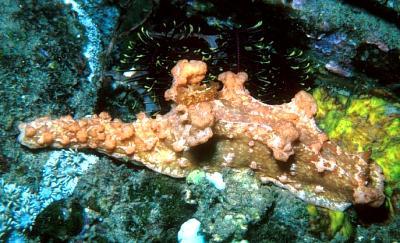
Hi Bill,
I don't think Ceratosoma moloch has made it into the Forum yet. Here is a specimen I found in 1994 in the Solomon Islands. It was out crawling around at night off the tip of Pt Cruz at the edge of Honaira harbor on Guadalcanal, at a depth of about 10m.
Scott
johnson@kmr.ll.mit edu
Johnson, S., 2001 (Jan 2) Ceratosoma moloch from the Solomon Ids. [Message in] Sea Slug Forum. Australian Museum, Sydney. Available from http://www.seaslugforum.net/find/3432Dear Scott,
Ceratosoma moloch hadn't made it but thanks to you it now has. Your photos shows how the tubercles thicken up and become quite rounded - a bit like encrusting coralline algae - when this species reaches about 120mm in length. In smaller (younger) animals, like in the photos at the top of the page, the tubercles are better described as flattened plates.
Bill Rudman
